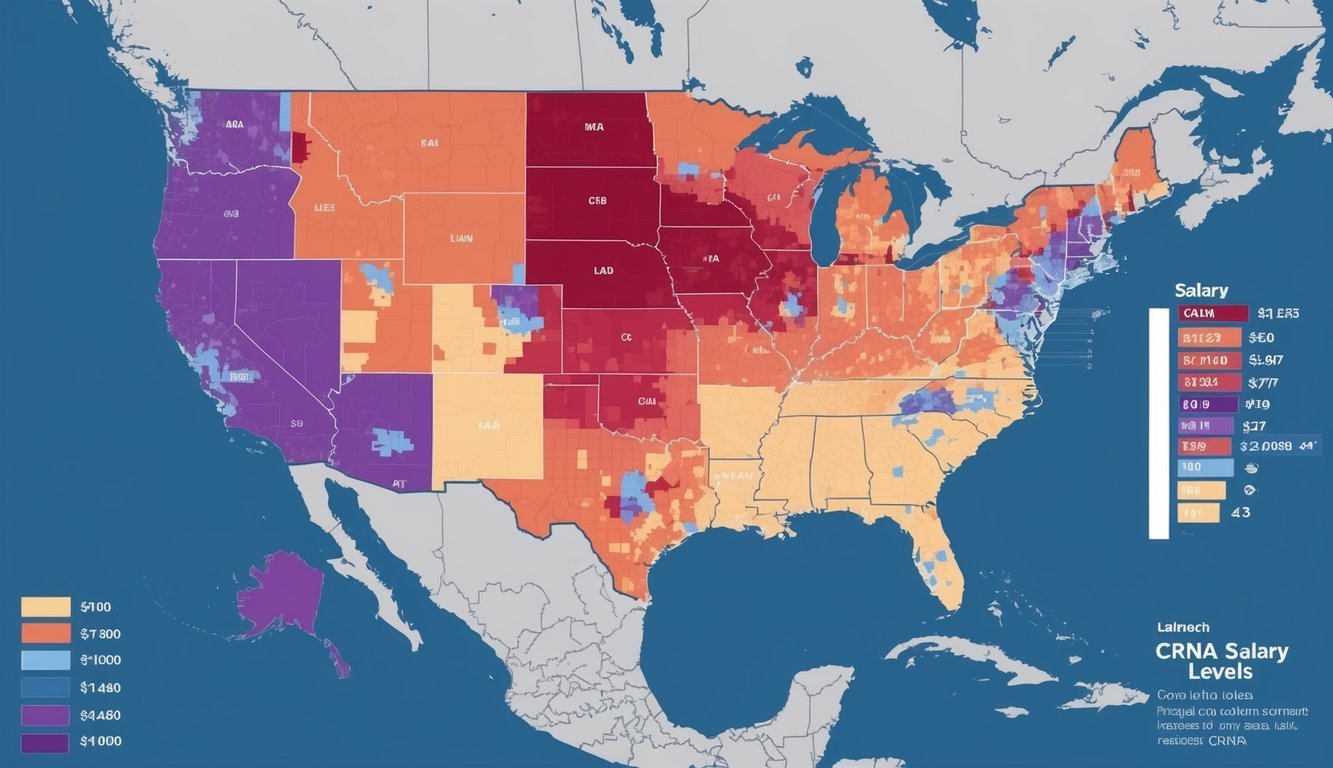As you explore career options in healthcare, you may be considering becoming a Certified Registered Nurse Anesthetist (CRNA).
This role is not only critical in administering anesthesia but also comes with significant financial rewards. The average salary for a CRNA is approximately $212,650, making it one of the highest paying positions within nursing.
Understanding the factors that affect CRNA salaries is essential.
Your earnings can vary based on location, years of experience, and the specific healthcare setting in which you work.
In states like New Jersey, CRNAs can earn significantly more than the national average, with salaries exceeding $259,707 in some cases.
Exploring resources like the U.S. Bureau of Labor Statistics can provide insight into regional salary variations and job outlook trends.
If you’re passionate about anesthesia and patient care, pursuing a career as a nurse anesthetist might be an excellent path for you.
By delving into the salary potential and job responsibilities, you can make an informed decision that aligns with your career goals.
Understanding CRNA Roles and Responsibilities

Certified Registered Nurse Anesthetists (CRNAs) play critical roles in patient care, particularly in anesthesia and pain management.
Their responsibilities encompass advanced clinical practices that require both knowledge and experience in the healthcare field.
Advanced Practice Registered Nurses
As Advanced Practice Registered Nurses (APRNs), CRNAs are qualified to provide anesthesia care autonomously.
This includes assessing patients, developing anesthesia care plans, administering anesthesia, and monitoring patients throughout procedures.
CRNAs must have a deep understanding of physiology and pharmacology, as these allow them to administer appropriate anesthetic agents safely.
They also provide crucial education to patients regarding the anesthesia process.
To maintain competency, CRNAs often participate in continuing education related to life support techniques.
Their role not only focuses on technical skills but also emphasizes patient safety and comfort.
Critical Roles in Various Healthcare Settings
CRNAs are integral to various healthcare environments, including hospitals, outpatient surgery centers, and pain management clinics.
In surgical settings, they work alongside surgeons and other healthcare professionals to ensure effective anesthesia administration.
They are essential in emergency situations, providing anesthesia for trauma patients or during cesarean sections.
Outside of surgery, CRNAs often manage chronic pain through various techniques, enhancing patients’ quality of life.
Their ability to assess and respond to complications, such as respiratory distress, is pivotal.
CRNAs also collaborate in interdisciplinary teams, often taking the lead in formulating anesthesia plans that consider a patient’s medical history and unique factors.
CRNA Salary Overview
The salary of Certified Registered Nurse Anesthetists (CRNAs) varies widely based on several factors, including experience and work settings.
Understanding these aspects can help you navigate your career in nurse anesthesia effectively.
Factors Influencing Nurse Anesthetist Compensation
Several elements affect the nurse anesthetist salary.
Experience plays a significant role; entry-level CRNAs can expect an annual mean wage of around $135,080, while those with more than eight years can earn up to $247,078.
Other factors include geographic location and the specific healthcare facility type.
For example, CRNAs in states like New Jersey and Alaska have salaries that exceed the national average by significant margins.
Additionally, working in metropolitan areas often provides higher salaries due to increased demand and cost of living.
Comparative Analysis by Work Settings
The work settings you choose can significantly impact your total compensation.
CRNAs work in various environments, including hospitals, outpatient surgical centers, and pain management clinics.
Here’s a simplified view of average CRNA salaries by work setting:
| Work Setting | Average Salary |
|---|---|
| Hospitals | $221,401 |
| Outpatient Surgical Centers | Varies, often lower |
| Pain Management Clinics | Typically higher |
Hospital settings generally offer better benefits packages, while outpatient facilities may provide more flexible hours.
Understanding these differences can guide your career choices and potential earnings.
For additional insights into nurse anesthetist salaries, visit Nurse.org.
Geographical Variations in CRNA Salary

CRNA salaries can vary significantly based on geographic location, influenced largely by the cost of living and demand in each area.
Understanding these variations can help you make informed career decisions.
Impact of Living Costs on Salary
The cost of living is a critical factor affecting CRNA salaries.
In regions with higher living expenses, salaries often reflect these costs.
For instance, urban areas typically offer higher salaries to attract talent but come with increased living costs.
In states like California and New York, where living expenses soar, a CRNA might earn a median salary significantly above the national average.
Conversely, rural areas or states with lower living costs may offer reduced salaries, despite a lower cost of living.
It’s essential to balance salary against living expenses to understand your overall financial health.
A relatively high salary in an expensive area may provide less purchasing power than a modest salary in a more affordable location.
State-by-State Salary Guide
Understanding CRNA salaries by state gives you a clearer view of potential earnings across the country.
Below is a simplified table highlighting average CRNA salaries in select states:
| State | Average Annual Salary | Hourly Rate |
|---|---|---|
| California | $247,078 | $118 |
| New York | $232,630 | $111.84 |
| Texas | $205,910 | $99 |
| Florida | $221,316 | $106 |
| Pennsylvania | $238,556 | $114.50 |
States like New Jersey and Texas show marked differences in salaries.
Outpatient care centers in urban regions may pay more due to higher patient volumes, while critical access hospitals might offer competitive salaries to attract CRNAs in less populated areas.
CRNA Education Path and Certification
To become a Certified Registered Nurse Anesthetist (CRNA), you need to follow a detailed educational path that includes specific prerequisites and advanced training.
Understanding these steps is crucial for your successful transition into this specialized nursing field.
Nurse Anesthetist Program Prerequisites
Before enrolling in a CRNA program, you must complete certain prerequisites.
Typically, these include:
- Bachelor of Science in Nursing (BSN): Obtain this degree as a foundational requirement.
- Registered Nurse (RN) License: Hold an active RN license.
- Critical Care Experience: Gain a minimum of one year in a critical care setting, such as an ICU or ER.
- Graduate Record Examination (GRE): Some programs require GRE scores for admission.
Many CRNA schools look for candidates with a strong academic background, particularly in sciences.
Courses in pharmacology and anatomy are especially beneficial.
Be prepared to present a compelling application that demonstrates your clinical experience and commitment to anesthesia.
Advancing from RN to CRNA
Once you meet the prerequisites, you can apply to a CRNA program, which often leads to a Doctor of Nursing Practice (DNP) degree.
A typical CRNA program involves:
- Length: Programs typically last 3-4 years.
- Curriculum: Courses cover advanced pharmacology, physiology, and anesthesia techniques.
- Clinical Practice: Extensive hands-on clinical training is integral to develop your anesthesia skills.
Upon completing the program, you must pass the National Certification Examination to achieve CRNA certification.
This certification signifies your competency in the field and is necessary for practice.
The rigorous education pathway ensures that you are well-prepared for the responsibilities of a nurse anesthetist.
For details on various CRNA schools, consider checking resources like Nurse.org.
Career Advancement and Professional Development

Advancing your career as a Certified Registered Nurse Anesthetist (CRNA) involves focused strategies for long-term growth and a commitment to ongoing education.
Understanding the pathways available can enhance your job satisfaction and support your professional journey.
Long-Term Career Growth
As a CRNA, you have various opportunities for career advancement.
You may explore roles such as clinical leadership, education, or even practice management.
Many CRNAs transition into academic positions or become involved in research, contributing to advancements in anesthesia practice.
Consider specialized certifications, which can significantly increase your earning potential and marketability.
Increasing your level of education, such as obtaining a Doctor of Nursing Practice (DNP), can also open doors to advanced practice roles.
Here’s a brief overview of potential career paths:
| Career Path | Description |
|---|---|
| Clinical Leader | Oversee CRNA teams and policies. |
| Educator | Teach in nursing programs or workshops. |
| Researcher | Contribute to studies that improve practice. |
| Consultant | Provide expertise to healthcare organizations. |
The Importance of Continuing Education
Continuing education is vital.
It helps you maintain your skills and knowledge in an evolving healthcare landscape.
Many states require ongoing education for licensure renewal.
This emphasizes the importance of staying current with best practices and innovations.
Participating in workshops, conferences, and online courses can enhance your expertise and network.
Seeking continuing education hours not only helps you meet recertification requirements but can also lead to greater job satisfaction.
Regular participation in educational opportunities can keep you competitive in the job market and improve your clinical effectiveness.
You can explore platforms like the American Association of Nurse Anesthetists (AANA) for resources and programs tailored to CRNAs.
Prioritizing education helps ensure your career progresses alongside the latest advancements in anesthesia care.

